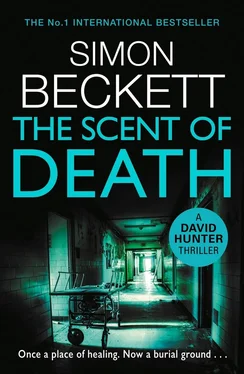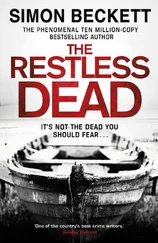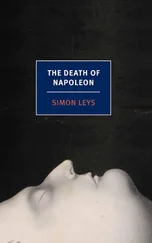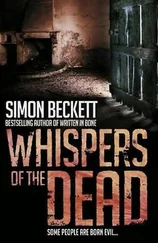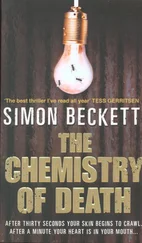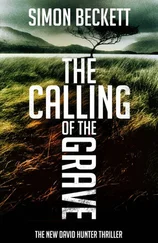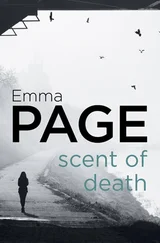A platform of stepping plates had been set up just inside the loft doorway, forming a temporary floor on the joists. A space had been left clear in their middle, exposing a patch of filthy loft insulation. In the white glare of floodlights, two SOCOs were poring over it on their hands and knees.
‘We found this a few hours ago,’ Whelan told me. ‘What do you make of it?’
I crouched down beside the uncovered area of insulation. It was very close to the doorway, and the uneven, dirt-matted surface was covered with hundreds of tiny dark specks, like grains of black rice. They were arranged in an approximate ring, more or less oval in shape. Its centre was almost clear, but then the flecks grew in density before thinning out at the edges.
I picked one up, turning it carefully in my gloved fingers. The papery husk was split in half and hollow, the creature it contained long gone. Most of the others were the same, although I could see a small number of whole pupae where the insect inside had failed to hatch. We were old acquaintances, Calliphoridae and I. The maddening buzzing of the adult flies provided an accompaniment to many of the crime scenes I attended. Although I’d no love for them, I respected the role they played. Not only in breaking down decaying organic matter, including human flesh, but in determining how long ago an individual had died. Blowflies were nature’s stopwatch, their lifecycle — from eggs to larvae to adult insect — an invaluable aid in estimating time since death.
The clock here had stopped a long time ago — too long to be any use now. Even so, that didn’t mean these empty shells had nothing to tell us.
‘I’d get a forensic entomologist to confirm it, but they’re mainly blue- and greenbottles,’ I said, examining the empty casing. ‘I can’t see any larvae among them, but there wouldn’t be after all this time.’
Any larvae would have either pupated and hatched, or died and disintegrated once the food source was no longer available. But although the body that once lay here was gone, there were clear signs of its presence. The glass-fibre insulation was stained and matted where decompositional fluids had leached on to it, and the random pattern of the discarded fly casings had been disrupted. In places the husks were crushed and flattened.
‘Looks like you were right,’ Whelan said. ‘The body lay here until it mummified, then it was moved further into the loft.’
‘Did you get anything from the tarpaulin she was wrapped in?’ I asked.
‘Maybe.’ He sounded deliberately non-committal. ‘There are what look like dog hairs on it, and we found a human hair caught in one of the eyelets. Different colour to the victim’s so it isn’t one of hers. We’ll check the DNA from it against the database, see if we can find a match, but that’s going to take time. The tarp itself is the sort of thing you could find in any DIY outlet or builder’s yard. The powder on it was a mix of cement and plaster dust like we thought, and the blue paint’s fairly generic, so we can’t pin it down to any particular brand. I’d say whoever moved the body was in a hurry and grabbed whatever they had to hand rather than buy a new one. Although that doesn’t explain why they waited so long in the first place.’
‘They?’
He gestured around us. ‘This is a good twenty or thirty yards from where we found her. Unless someone took the time to put boards down the body would have to be carried. Easier with it wrapped in the tarp, but I can’t see one person managing on their own. Not the weight so much, just balancing all that way on the joists without putting a foot through the ceiling.’
It was a good point. And if the woman’s body had been dragged it would have left a trail of disturbed insulation in its wake, as well as causing substantial post-mortem damage to the fragile remains. I’d seen no indication of that.
I looked again at where the body had been. As well as discolouration from the decomposition, there was a lighter patch of staining on the insulation, as though some paler fluid had dried there. ‘What’s that?’
One of the SOCOs shook her head. ‘Not sure. It’s not dark enough for blood. We found splashes of what could be the same stuff on the wooden steps outside, so it might not even be from the body. Could be something that somebody just spilled. We’ve sent samples for analysis, but whatever it is it’s too old and dry to tell us much.’
‘We did find something else, though,’ Whelan said. He pointed at the inside of the doorframe. ‘See here?’
There were splintered gouges in the unpainted timber, lighter than the surrounding wood.
Scratches.
‘Explains the damage we saw on the woman’s hands,’ Whelan said. ‘We dug one of her fingernails out of the woodwork. The door was fastened from the outside and it’s pretty solid. Too heavy for her to prise open or break down, but she gave it a good go.’
God, I thought, imagining it. We’d thought the woman had been killed somewhere else and then her body had been carried up to the loft. We were wrong.
Someone had locked her in here and left her to die.
‘What I can’t understand is why she didn’t get out through one of the other exits,’ the second SOCO said. He was an older man, with worried eyes above his mask. ‘It’s not like this was the only one.’
‘How would you feel, crawling around up here if you were pregnant? You made hard enough work of it with your beer gut,’ his colleague countered. ‘And how would she know where they were? It’d be pitch black, and we haven’t found a phone or cigarette lighter she could have used for light. One slip and she’d have been through the ceiling.’
‘I was only saying,’ he muttered, sounding hurt.
I was still trying to make sense of what had gone on here. ‘Why would anyone lock her inside and then just leave her?’
Whelan gave a shrug. ‘I suppose there’s a chance it could have been unintentional, some sort of prank gone wrong. People do all sorts of things when they’re drunk or high, and we know a lot of addicts use this place. But I can’t see a pregnant woman hiding in a loft for a laugh, high or not. I’d say someone either forced her in here or else she was being chased and tried to hide. Either way, someone fastened her inside and then left her. Leastways until months afterwards, or however long it was. Could be when they heard the hospital was going to be knocked down they decided to shift the body to where it was less likely to be found.’
It was as good a theory as any. But the idea of the pregnant woman being chased reminded me of something the SOCO had mentioned earlier.
‘The pale stains on the insulation,’ I said, looking at the matted glass fibre. ‘You said there were splashes of something similar on the steps outside. Could it be amniotic fluid?’
The female SOCO sat back on her heels, considering. ‘Yeah, I suppose it could. But I think the stains will be too old to say one way or the other.’
‘You’re thinking her waters broke?’ Whelan asked me.
‘It’s possible. But if they did, from what I saw of the foetus it would have been premature.’
‘So she could have died from that.’
I nodded, sobered by the thought. Without medical attention, if the membranes around the amniotic sac ruptured early it could be life-threatening in far better conditions than this. Trapped in a loft without even food or water, the woman and her child would have had no chance of survival. Only a slow death in the dark.
No one spoke, then Whelan turned back to the doorway.
‘Come on,’ he said heavily.
As we tramped down the wooden stairs I stopped by the dried splashes the female SOCO had spoken about. They were only faint, more like watermarks than blood. There were several of them, some little more than drops that led in an uneven trail up the stairs to the loft.
Читать дальше
